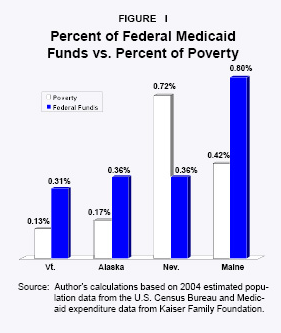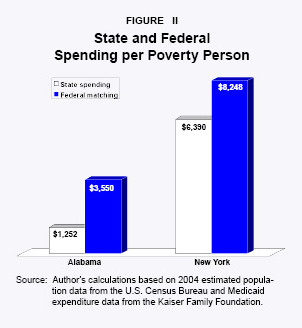Medicaid is a joint federal-state health care program, primarily for the poor. At the federal level, Medicaid is an entitlement, implying that each enrollee has a right to benefits, regardless of the state in which he or she resides. However, federal funds are not distributed equally. Each state budgets its own Medicaid spending, but receives federal funds based on a matching formula. Wealthy states that spend more on Medicaid receive more federal funds, while poor states, which tend to have larger poverty populations, receive less. Why are there such disparities in the Medicaid program, and what should be done?
Where Medicaid Dollars Go. The states spent about $112 billion on Medicaid in 2004; of the total cost, more than half ($176 billion) was paid from federal coffers. Federal funds are distributed based on a matching formula that takes into account each state's personal income per capita relative to the national average. Using this method, many states receive far more or far fewer Medicaid dollars than they would if funds were allocated based on a state's poverty population. In 2004, for example:

- New York, with 7.9 percent of the nation's poverty population, received almost 13 percent of federal Medicaid dollars.
- In contrast, Texas had 10.3 percent of the nation's poverty population, but received only 6 percent of federal Medicaid dollars.
- Vermont, Alaska and Maine received twice as much as they would if funds were allocated based on their poverty distribution, while Nevada received half as much. [See Figure I.]
Overall, 23 states received less than their share of the poverty population would merit, while 27 states received more. In fact, one-in-four federal Medicaid dollars (roughly $44 billion) would have been allocated to different states if funding was based on the poverty distribution alone.
Why Some States Get More Funds Than Others. In theory, the federal funding formula is designed to narrow the disparities in the ability of states to fund Medicaid by giving poorer states a higher matching rate for every dollar they spend. However, there is no cap on the amount that the federal government matches. Therefore, the more a state spends, the more it receives. In practice, states with above-average per capita incomes are likely to spend more on Medicaid and receive more federal dollars. For example:
- In 2004, New York, with an above-average income per capita, spent more than five times as much in state funds per poverty person (those at or below the federal poverty level) as Alabama – $6,390 compared to $1,252. [See Figure II.]
- Even though New York's federal matching rate is lower than Alabama's, it received more than twice as much funding per poverty person – $8,248 compared to $3,550 for Alabama.

Arguably, spending per poverty person is not the appropriate standard to measure federal spending, since many states cover many individuals above the poverty level, while others do not. In fact, the disparities between states with above-average per capita incomes and states with below-average per capita incomes are even wider when comparing spending per enrollee. For example:
- New York, Connecticut, Massachusetts, New Jersey and New Hampshire spent more than $4,000 in state funds per enrollee, and each received $5,000 per enrollee from the federal government – thus they spent more than $9,000 per enrollee!
- On the other hand, Arkansas, Alabama and South Carolina spent less than $1,100 of their own funds per enrollee; combined with federal funding, spending per enrollee was less than $4,000.
Higher health care costs do not explain the higher spending. Comparing New York City, where living costs are much higher than the national average, to Columbus, Ohio, where the local cost of living is at the national average: - In fiscal year 2003-2004, Medicaid spending in New York City averaged $9,842 per enrollee, almost twice as much as the $5,082 spent in Franklin County (Columbus).
- Adjusted for the cost of living in each area, New York City spending per enrollee was still twice as high as in Columbus, Ohio.
An Equitable Solution. The goal of Medicaid is to provide health care for the poor, but the federal government has made it into a "free-for-all" for states, rewarding those that spend the most. Bringing some common sense to the funding method would help contain spending growth by removing the incentive of states to spend more. It would also distribute federal funds for the poor more equitably.
- Federal funds could be allocated to states based on their poverty distribution; if a state has 10 percent of the nation's poverty population, it would receive 10 percent of Medicaid funds.
- States could choose to cover optional populations with their own funds.
- Federal funding per poverty person could be capped, so that states do not have an incentive to spend more simply to receive more funds.
States should have the flexibility to use their federal funds as they choose. For instance, they could provide vouchers for Medicaid enrollees to purchase private health insurance, fund Health Savings Accounts or pay premiums for employer-provided insurance.
Conclusion. The goods news is that the Deficit Reduction Act of 2005 allows states to use their funds to experiment with Medicaid program modifications. But the matching formula needs to be changed as well. Distributing federal funds on the basis of need would help equalize Medicaid funding and encourage states to moderate their spending growth.
Pamela Villarreal is a graduate student fellow with the National Center for Policy Analysis.